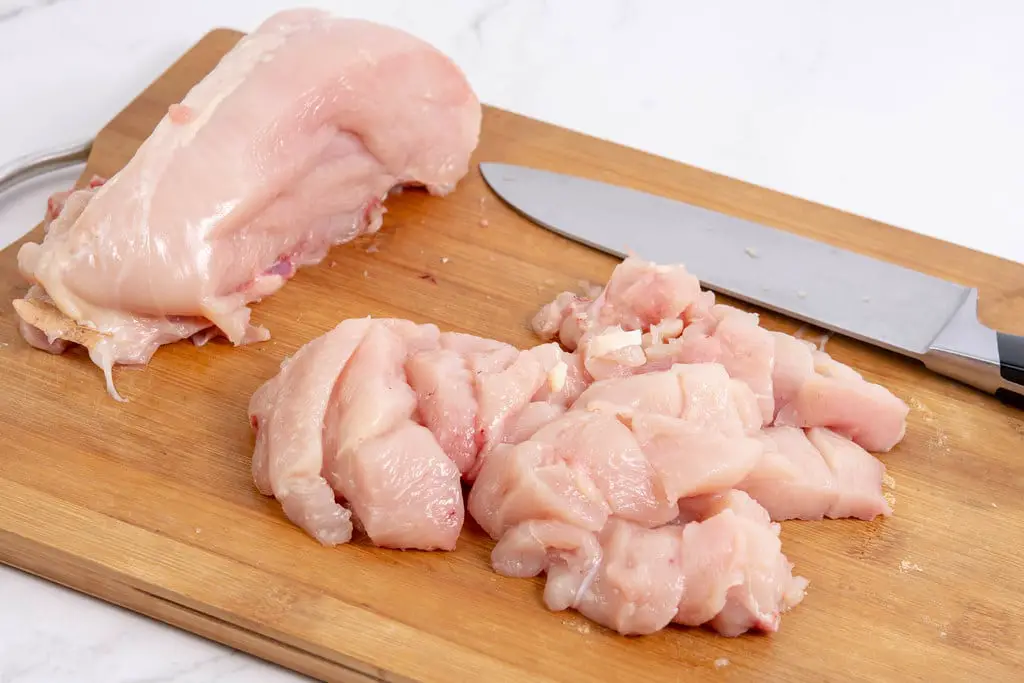Ensuring Safety and Quality: Understanding Red Spots on Chicken Meat and Proper Handling
Chicken meat is versatile but sensitive to handling and can easily be infected with salmonella. Any mark on the chicken meat might cause an alarm and raises questions about its safety. Red marks on chicken meat are often a result of blood spots caused by poor handling during the slaughtering or packaging process.
Such chicken meat is generally fit for consumption, subject to proper cooking. In this article, we will look at how to identify chicken meat that is safe for humans and how to cook and store it properly.
What Causes Red Spots On Chicken Meat?
Several factors could lead to blood spots on chicken meat.
Air Chilling
An air-chilled chicken will likely have red spots. A chicken is chilled immediately after de-feathering and might not have a chance to drain all blood properly. When packed, these blood spots will appear reddish on the meat.
Poor Handling
Chicken meat is quite tender, and when mishandled during de-feathering, there can be small blood clots on the skin. If a chicken was maltreated during its lifetime, any pressure applied on the skin forms red spots.
During packaging, if all blood is not well drained, it will get stuck on the skin, forming red spots. The skin may also appear reddish on some parts due to stacking the chicken during storage or transportation.
Skin Imperfection
On rare occasions, you will find a chicken with imperfect skin. In some cases, you may not be able to point at the cause of the imperfection. If you are in doubt of its safety, you better trust your gut feeling and trash it.
Poor Butchering Process
Some butchers may not be careful enough when handling chicken. Improper slaughtering techniques could cause blood to clot, causing red spots on the meat. It is crucial to get your chicken meat from reputable butchers or stores.
Improper Storage
If you fail to store your chicken meat properly, it might get contaminated and have red spots. Likewise, a butcher may have stored the chicken meat improperly, leading to contamination. You should avoid consuming contaminated chicken.
How To Sort Red Spots On Chicken Meat
Red spots caused by blood spots are easy to remove using any of these methods;
- Run the chicken meat under cold water for a few minutes until the red spots clear.
- Blanch the chicken meat in hot water for two minutes.
What To Look Out For In Chicken Meat
Appearance
Fit-to-consume chicken meat appears pinkish. If you see the chicken has turned gray or dull, it is not fit for consumption. Dispose of it properly, avoiding contact with other foods or surfaces. Avoid chicken meat with bruises and tears on the thigh and wings.
Aroma
A fresh chicken has a mild bloody and somewhat metallic aroma when uncooked. If you notice any unpleasant smell, the meat has spoiled and can be harmful if consumed.
Firmness
Fresh-cut chicken meat should be firm and spring back when pressed. A cut that is too soft to touch may have sat in the store for a long time. Avoid bloated meat; it could be a sign that it has been injected with steroids to appear big. The breast should be plump and appear tender and young.
Grading
In the US, chicken meat is graded in three categories, A to C, with A being the best quality.
Enhancement
If on the label of the chicken meat you find the term enhanced, it means that it has been injected or soaked with a solution while processing. Some of these solutions include MSG, sodium, nitrites, and nitrates, altering the natural flavor and increasing the risks of side effects of consuming the meat.
Certified Organic
For a producer to attain organic certification, they must have followed strict compliance guidelines and humanely treated the chicken at every stage. Chicken meat certified organic is free from antibiotics and hormones harmful to humans when consumed.
Liquid In Package
Avoid chicken with excess liquid in the packaging. The liquid alters the texture of the meat and makes it soggy.
Chilling Process
Opt for air-chilled chicken meat other than water-chilled one. A 100% pure chilled chicken does not come into contact with water hence the texture is preserved, and the skin remains crispy.
Sell By Date
Before you buy chicken meat, check the expiry date. Avoid one that has a close sell-by date. It means it has been in the store for a period and will soon be unfit for consumption.
Tips On Handling Chicken Meat Safely
Chicken can easily be infected with salmonella, a bacteria that causes food poisoning when passed to humans. This bacteria usually causes severe side effects and in some extreme cases, death. Some of the tips that can help you handle chicken meat properly include;
- Avoid raw chicken from coming into contact with other foods or utensils. While transporting from the store, pack in a polythene bag to prevent the juices from contaminating other items.
- Ensure you cook the meat thoroughly until you achieve an internal temperature of 165 degrees Fahrenheit and above.
- Buy organic or GMO-free meat; they are a healthier option.
- Look out for any sign of spoiling before cooking chicken meat. These signs include; gray or dull color, pungent smell, molds, and slimy texture. You should trash the chicken meat if it’s spoiled.
- For longer shelf life, freeze the meat. A whole chicken can stay fresh while frozen for one year and nine months when cut into pieces.
- Refrigerate leftovers two hours or less after cooking. Avoid storing chicken at room temperature.
In conclusion, chicken meat is a healthy dish but can get contaminated easily. Any spots or marks on the skin can cause panic. Red spots on meat are normally blood spots on the skin due to poor handling, processing, or packaging. Meat with such spots is safe for consumption if there is no other cause of alarm, provided it is well cooked.






